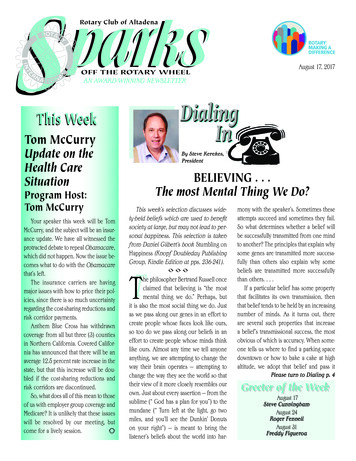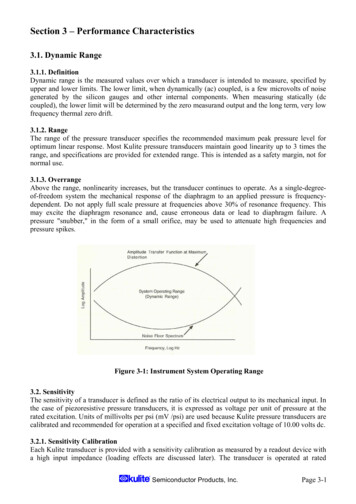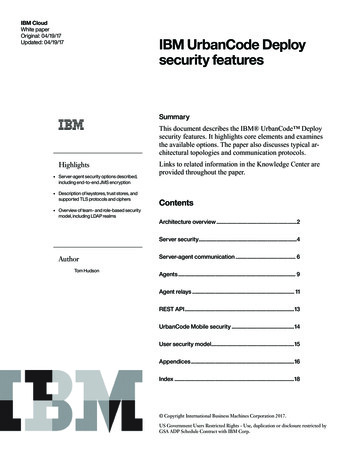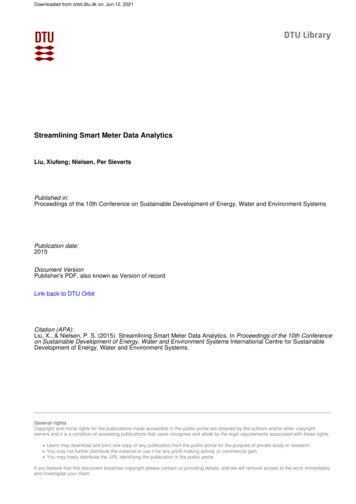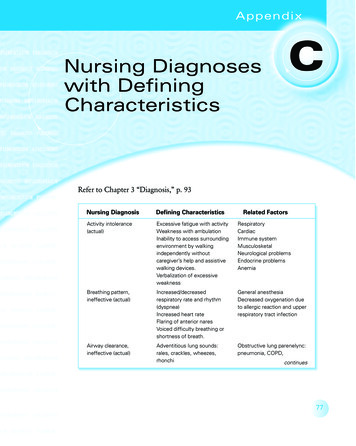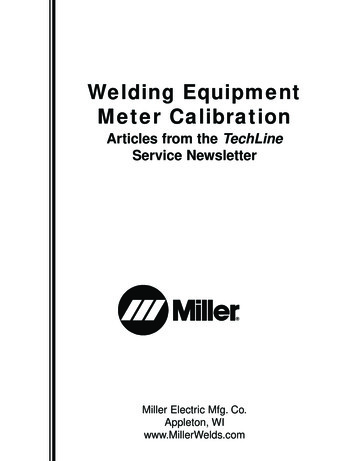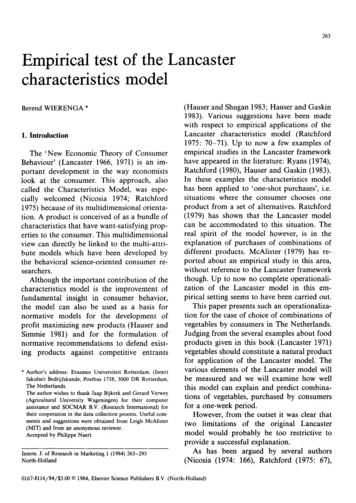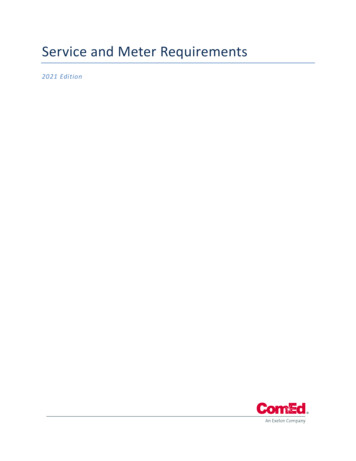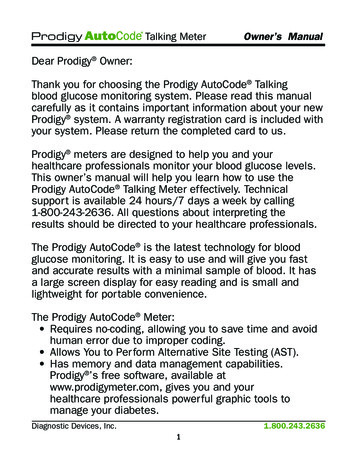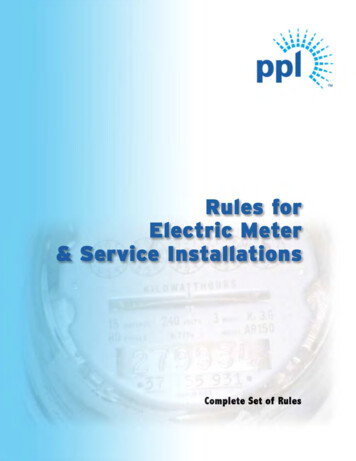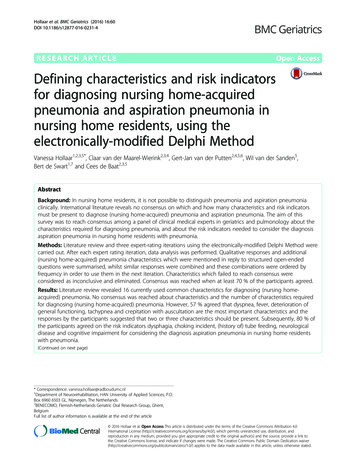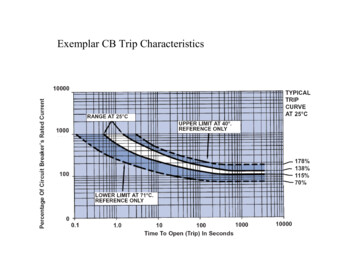
Transcription
CHARACTERISTICS OF ROTARY METER PERFORMANCEKevin BeaverGE Oil & Gas – Meters and Instruments16240 Port Northwest Dr. Houston, TX 77041This paper highlights several rotary meter performancecharacteristics. These characteristics profile a rotarymeter’s capabilities in a wide array of applications fromproduction to transmission, and distribution. Most of thecharacteristics have minimum standards adopted byagencies like AGA or ASTM. I will identify these standards,and incorporate them-where applicable-into my paper.In discussing these characteristics, I hope to give thereader a better understanding of the capabilities of rotarymeters, and how the gas industry assesses thesecharacteristics. Here are the performance characteristicsI will discuss: Rangeability Start Rate Stop Rate Stating & Running Differential :1223:15000:1If you have the characteristic accuracy curve for a rotarymeter you can plot the point on the curve where accuracyreaches a 1% or 2% point. Since most manufacturerspublish curves you have another method of calculatingrangeability. Take a look at the following 5M175 accuracycurve:RANGEABILITYThe most frequently used performance standard for arotary meter is rangeability. Rangeability is a meter’smaximum rated capacity-in CFH-divided by its minimumcapacity. Minimum capacity is usually the flow where themeter’s accuracy drops below a one-percent accuracyband. For example, you’d calculate the rangeability of a5M175 as follows:Maximum rated capacity of a 5M:5,000 CFHCapacity of 5M at minus 1% accuracy: 41.665M175 Rangeability:120:1Your rotary meter vendor can supply rangeabilityinformation for all the rotaries that you purchase. Typicallygas distribution companies focus on rangeability at a one-percent accuracy band. You will see published datafor two-percent, and the meter’s operational range. Youcalculate operational rangeability by dividing the meter’smaximum flow rate by its start rate. I’ll discuss start ratesin the next section of this paper. Here’s a tablesummarizing rangeability values from a large rotary metervendor:MeterSize8C11C15C2M3M5MRangeability: One Percent26:131:140:168:176:1120:1Rangeability: Two ability286:1478:1789:11053:11429:14167:1If you plot the point where the accuracy curve crosses the99% threshold, you will see that the corresponding flow is alittle less than one percent. This method won’t enable youto derive the exact rangeability value, however it will enableyou to estimate rangeability if you don’t have the suppliersexact values.START RATESA rotary meter’s start rate is simply the flow rate at whichthe impellers start-and continue-rotating. The start flowrate does not approximate a specific accuracy value.However, most rotary meters register 70 to 90 percentaccuracy at the start rate. The specific accuracy value atstarting flow will vary by manufacturer and meter size. TheAmerican Gas Association adopted a minimum-starting ratefor rotary meters. You can find this standard in ANSI reportnumber B109.3.This report details rotary meterconstruction standards, and acceptable performance levels.Regarding start rates, ANSI B109.3 specifies that each sizestarts-and continues to run-at less than or equal to 0.5
percent of rated capacity. Here’s a table that highlightstypical start rates and the minimum acceptable ANSIB109.3 standard:
METER SIZE8C11C15C2M3M5M7M11M16MSTART RATEIN CFH2.82.31.91.92.11.25.33.93.2MINIMUM ANSISTD IN CFH45.575.101525355580Calculating start rates requires some precisionmeasurement equipment. Typically you’ll need a testsetup that includes the following equipment: Laminar Flow Element: for measurement of theflow rate Liquid Manometer: for readout of the flow rate Rheostat: for flow rate adjustment Cadillac Blower: for air flow Barometer & thermometer: for pressure &temperature readings Stopwatch: for assessment of test duration Couplings & Flanges: for meter connectionsIn a typical start flow rate test set-up you pull air throughthe meter and laminar flow element with a blower. Youthen set the flow rate-with the rheostat-to the pointwhere the meter impellers begin rotating. Next youcontinue adjusting the rheostat until you reach theminimum flow in which the impellers turn for two minutes.To assure test accuracy you should run the start testprocedure 6 to 10 times. Then average these results foryour final start flow. To derive the actual start flow rateyou note the differential pressure at each start flow.Calculate the average differential. Plot this average onthe calibration curve supplied with your flow element.From this plot you can derive the corresponding flow rate.Finally, you’ll integrate pressure and temperature factorsinto your final calculation. Your flow element includes achart for pressure and temperature correction factors. Thisprocedure is the framework for an accurate assessment ofstarting flow rate. It’s also the framework for anassessment of the stop rate I’ll discuss in the next section.STOP RATEA rotary meter’s stop rate is the flow rate where theimpellers do not rotate. An examination of the followingdiagram illustrates this performance characteristic:This diagram depicts the pockets of gas trapped between themeter impeller and cylinder. During each impeller rotation,the rotary meter traps four pockets of gas. There’s a smallgap between the impeller edge and cylinder. This gap,typically in thousands of an inch, varies by meter size. Atthe rotary meter’s stop rate, gas flows through this gapunmeasured. You assess the stop flow rate in a similarmanner in which you assessed the start flow rate. One stepin the start rate test procedure, not mentioned in theprevious section, requires a determination of the flow whereimpellers do not rotate. Most rotary meter vendors publishthis data. It’s very useful in judging the rotary’s overallperformance capabilities. Here’s the stop rate data publishedby one major rotary meter vendor:METER SIZE8C11C15C2M3M5M7M11M16MSTOP RATEIN CFH2.01.71.61.11.80.83.43.21.9
The difference between the start and stop rate for aspecific size is due to test parameters. Remember thestart rate flow is sustained for two minutes. Flowsbetween the published start and stop rates do notmeet the two minute duration criteria. The nextperformance criteria I’ll discuss concerns pressure dropacross the meter.STARTING & RUNNING DIFFERENTIALDifferential pressure measurements are an importantcomponent of rotary meter performance assessment.A rotary meter’s differential characteristics reflect anarray of performance capabilities. I’ll group thesecapabilities as minimum standards and as an indicationof changes in meter accuracy. First let’s examine theANSI differential standards.The ANSI B109.3standard requires a minimum starting differential, andthe publication of running differential values. Thisstandard mandates the documentation of thedifferential at starting flow. Moreover, the startingdifferential shall not exceed 0.10inch water columnwhen tested with air at atmospheric conditions. Thefollowing table shows one manufacturer’s compliancewith this part of the ANSI B109.3 standard:METER 05.013.007.009*AVG START PGAS .459.590.639.828.9461.2701.3871.641AVG RUNNING P*GAS (0.6SP).208.275.354.383.497.568.762.832.985drops high enough to cause problems in the low-pressuresystems found in urban areas.ACCURACYIn the concluding section of this paper I’ll discuss rotarymeter accuracy from two perspectives. First, I’ll profile theB109.3 accuracy standard. Secondly, I’ll discuss overallrotary meter accuracy.Overall rotary accuracyincorporates many of the operating characteristics—rangeability, start/stop rates—I’ve discussed in this paper.The ANSI B109.3 standard mandates that rotary metersinitial accuracy, at 10 to 100 percent of flow, be 100 1percent. Additionally B109.3 requires manufacturers toperform accelerated life tests on each meter size. Themanufacturer must operate the meter at 100 percent of flowfor 4,000 hours. After this accelerated life test thesustained accuracy must be with the same tolerance (100 1percent at 10 to 100 percent of capacity). The followingtable highlights one vendor’s initial and sustained accuracytest results:METERSIZEINITIAL ACCURACYSUSTAINED Differential at 100% flow rateRunning differential is important at many different flowrates other than full capacity. Since producers and LDCsuse differential testing for maintenance purposes, we needdata at all of a meter’s operating flows. If you develop adifferential curve—at least three flow rates—upon initialinstallation, you can use differential testing to determine ifa meter’s accuracy has changed from the last test.Therefore, having the manufacturer’s curve if operatingpressure is below 15 PSIG or your own curves for elevatedpressures are important.The curves show thatdifferential pressure changes as flow or pressure increases,and as internal resistance builds due to dirt or foreignmaterials.Another important issue concerning rotary meterdifferentials is their performance in low-pressure systems.The running differential data shown in the previous table isat each meter’s maximum flow rate. As the values in thegas column show, each meter size does not have pressureNow I’d like to tie together the characteristics I’ve discussedin this paper. Real world applications subject rotaries tovarying periods of start flows, stop flows, and maximumflow-rates. How do today’s meters perform in widelyvarying flow conditions? By calculating overall accuracy youcan answer this question. Since manufacturers publishcharacteristic accuracy curves you can calculate the hour byhour or day by day accuracy of a rotary meter. Thefollowing examples utilize performance characteristics ofnew meters. You can temper the results with in-serviceperformance data if your company tracks as-found accuracytests. Let’s take a look at two examples.My first theoretical example is a fast food restaurant loadwith a 15C175 rotary meter and a 10 PSIG delivery pressure.I’ll profile the overall rotary meter accuracy for a twenty-fourhour period.Since the rotary meter manufacturerpublishes start/stop data, and characteristic accuracy datafor the meter’s full operating range, we can derive theaccuracy over this twenty-four hour period. Here’s a
summary of the flows, time variables, and accuracy’s forthis example:
24 HOUR OVERALL ACCURACY FOR 15C175FAST FOOD LOADFlowrate(CFH)800250100351STD SCF)5301165649729013Accuracy(%)MeasuredVOL (SCF)100.1899.9899.5598.330.00531016564952850Total Measured Volume: 7746 (SCF)Total Actual Volume: 7757 (SCF)OVERALL ACCURACY: 99.8573 %In determining overall accuracy I used the 15C’s publishedaccuracy—from the accuracy curve and B109.3performance summary—for each of the five flow andduration conditions. With this information I calculatedmeasured volume (column six). Overall accuracy issimply total measured volume divided by total actualvolume. This approach can help you determine overallaccuracy for many different applications. Let’s take alook at a different theoretical load. In this example I’lldetermine overall accuracy for a one year time period:365 DAY OVERALL ACCURACY FOR 3M175OFFICE BUILDING LOADFlowrate(CFH)1241020200400150020003000STD redVOL 6251Total Measured Volume: 3,280,025 (SCF)Total Actual Volume: 3,280,134 (SCF)OVERALL ACCURACY: 99.9966 %Using new meter accuracy data we can easily calculateoverall rotary meter accuracy. Overall accuracyincorporates all the rotaries performance characteristicsfrom start rate flow rates through 100 percent capacity.This approach to accuracy assessment provides a goodstarting point in determining the viability of a rotary inyour measurement applications. Compare overallaccuracy with historical performance information, andyou’ll get a clear picture of what the rotary can do.During the last thirty years rotary meter manufacturershave made great strides in improving all performancecharacteristics. New materials (cast iron to aluminum),better machine tools (manually operated to computercontrolled), and better business process (quality inspectorsto statistical process control) have paved the way toimproved rotary meter performance characteristics. Thefuture holds many more improvements as manufacturerscontinue researching technological changes.
The ANSI B109.3 standard mandates that rotary meters initial accuracy, at 10 to 100 percent of flow, be 100 1 percent. Additionally B109.3 requires manufacturers to perform accelerated life tests on each meter size. The manufacturer must operate the meter at 100 percent of flow for 4,000 hours. After this accelerated life test the
